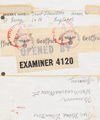May
Writing on the wall: new Schwitters letters revealed

Personal letters which give an insight into Kurt Schwitters’ vision for the Merz Barn artwork have been revealed for the first time.
Students from the School of Modern Languages at Newcastle University have transcribed and translated original letters Schwitters wrote from his internment camp on the Isle of Man and in the Lake District, the birthplace of the Merz Barn. It was during this time that he first conceived the ideas behind what is considered his greatest work.
Now the letters, along with the stories behind them, have been used to create 'Art in Exile', a new exhibition at the Hatton Gallery in Newcastle opening this week which puts the German artist’s years in Britain into context. They include a letter from 3 July 1947, in which he discusses the grant from the Museum of Modern Art in New York and the early beginnings of the Merz Barn.
Among these previously unpublished letters from the Kurt Schwitters Archive/Sprengel Museum in Hannover, Germany, is one he wrote to the intelligence officer at his internment camp on the Isle of Man, where he was kept as an ‘enemy alien’ after fleeing Norway in 1940 after the Nazis took power.
In the letter he says he has received a letter from a former internee in the same camp and complains that it has been censored to the point that some parts are unreadable. The letter refers to the art movement Dadaism and concerns a dispute between them.
With his work being referred to as ‘dangerous’ by the writer, Schwitters suggests that it may look a little suspicious if the reader did not know that he was considered as a danger not to any political party or cause - but to established art.
Some of the letters took laborious routes before they arrived at their destination, being examined by censors in England, only to be opened again in Germany, so his wife Helma often received letters with both an English stamp and red and a black eagle cum swastika upon them.
The exhibition looks at Schwitters’ art and life in the UK during the 1940s and the broader issue of emigration from Germany to the North of England. It also introduces the life stories of other WWII refugees who settled in the UK – Newcastle University’s famous archaeologist Brian Shefton and renowned Shakespeare scholar Ernst Honigmann.
“It has been a surprise and delight to see what has come to light in this treasure trove,” said Professor Henrike Lähnemann, Chair of German Studies in the School of Modern Languages. “For the students it was a great privilege to be trusted with these unpublished letters from the archive’s collection.
“Even though the Merz Barn has been here for nearly 50 years, it’s amazing how many people still think it’s in the Lake District and we want as many people as possible to know it’s here so they can come and enjoy it. With the retrospective at the Tate Britain and a renewed interest in Schwitters, we thought it was the perfect time to do something like this.
“The exhibition shows facets of emigration which remain relevant today. Britain's generous hospitality for thousands of refugees from Germany has transformed the academic and artistic landscape of the country in a lasting way.”
Schwitters’ Merz Barn is not the only cultural legacy he left to Newcastle. One of the portraits he painted on cheap wood at the internment camp came from the sitter Fred Uhlman to be with the Merz Barn. Schwitters inspired Uhlman to become an artist and art collector and his collection of African art and a painting based on it are now also in the Hatton Gallery. Collages from friends such as the photographer and artist Ella Bergmann-Michel similarly made their journey from Germany to the North East.
The Merz Barn, which has been in its current position in the Hatton Gallery since 1965, is one of the few surviving pieces of Schwitters’ Merzbauten (Merz buildings), making it a treasured piece. All of the collages were created with his bare hands and basic tools, often using what others may regard as ‘rubbish’.
After his death in 1948, the Merz Barn wall in the Lake District was left unfinished and was in danger of disintegrating in the elements. It was given to Newcastle University after Richard Hamilton, a fine art lecturer at the time, made a case to preserve it. Then art student Fred Brookes was nominated to oversee the move, which was a huge task given that the dry-stone wall could not be dismantled.
Schwitters@Newcastle is run by the German section of the University’s School of Modern Languages. The project is part of a wider aim to highlight the importance of the Merz Barn and its location in the Hatton Gallery. The Art in Exile exhibition, which opens on Thursday, 9 May and runs until 19 May, was organised with help from Rob Airey, Keeper of Art at the Hatton Gallery and Hazel Baron-Cooper, the gallery’s Education Officer.
Other activities which have taken place recently include a creative writing workshop to create collage poems in the style of Schwitters and Jumble Art, an art and German competition with schools across the North East.
The launch of the Art in Exile exhibition will include a talk by Emma Chambers, curator of the Schwitters in Britain exhibition at the Tate Britain in London at 4pm on Thursday, 9 May 2013 at the Hatton Gallery.
The link between German Studies in the North East and Schwitters' legacy will continue. There are still unpublished letters to explore and the Kurt und Ernst Schwitters Archive at the Sprengel Museum in Hannover is very keen to explore further collaboration.
Photograph © Kurt und Ernst Schwitters Stiftung, loan to Kurt Schwitters Archiv, Sprengel Museum Hannover, Germany
published on: 7 May 2013
